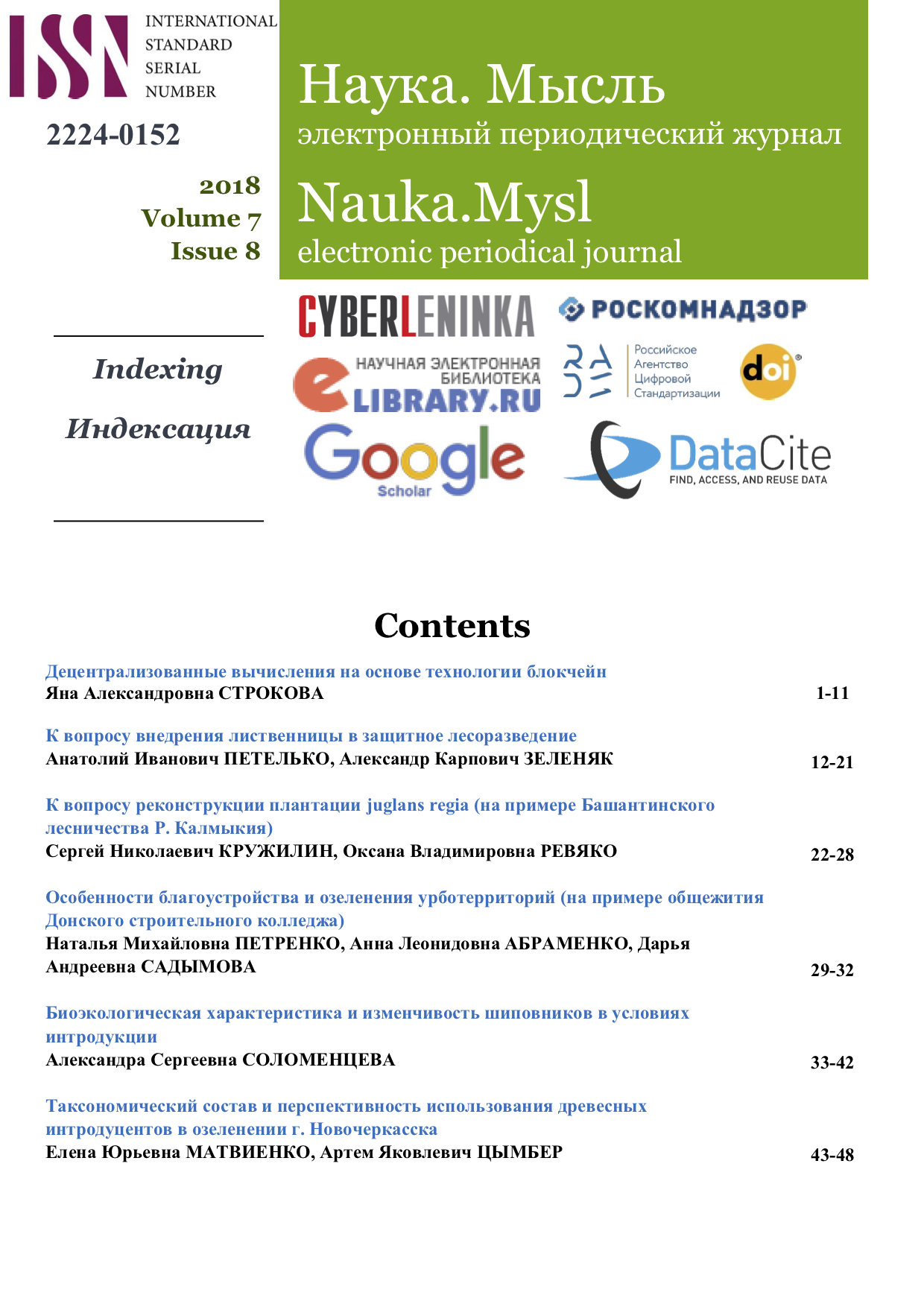Bioecological characteristics and variability of dog-rose under the conditions of introduction
DOI:
https://doi.org/10.25726/нмэнж.v7i8.13Keywords:
dogrose, polymorphism, bioecological potential, introduction, growth and development, adaptation, endogenous, population, geographical level.Abstract
The definition of bioecological characteristics and variability of various types of shrubs is aimed at selecting an adapted gene pool of economically valuable plants for the formation of protective forest plantations for different purposes in the steppe and semi-desert. Variability is determined by the peculiarity of growth and development, determines the correlation of organs within the individual; and also features of interaction of plant organs with the surrounding environment. The article presents materials on the study of the bioecological potential and the variability of dog-rose under the conditions of introduction. The species were studied: R. rugosa Thunb. - rose hips wrinkled, R. cinnamomea L. - cinnamon rose, R. beggeriana Shrenk. L. - Begger's dogrose, R. acicularis Lindl. - rose hips, R. ecae Aitch. - dogrose Eki, R. pom-ifera Herrm. - apple hips, R. spinosissima L. - wild rose hips, R. canina L. - common hips. The characteristics of their biometric indices, degree of spiny, variability in flowering, fruiting and formation of leaf blade are given. Data on water deficiency in arid conditions are given. Functional indices and parameters of their variability depending on the influence of limiting factors and various geographical points will be used for selection of the adapted gene pool under the conditions of introduction.
References
2. Мазуренко М.Т. Структура и морфогенез кустарников. М.: Наука, 1977.
3. Методические указания по семеноведению древесных интродуцентов в условиях засушливой зоны / А.В. Семенютина [и др.]. М.: Россельхозакадемия, 2010.
4. Серебряков И. Г. Экологическая морфология растений. М.: Высшая школа,1962.
5. Семенютина А. В. Дендрофлора лесомелиоративных комплексов / под ред. И. П. Свинцова. Волгоград: Вниалми, 2013.
6. Семенютина А.В., СвинцоВ И.Г., Костюков С.М. Генофонд кустарников для зеленого строительства. Москва: Наука. Мысль, 2016.
7. Семенютина А.В., Соломенцева А.С. Обоснование ассортимента шиповников для обогащения лесомелиоративных комплексов в засушливых условиях // Известия Нижневолжского агроуниверситетского комплекса. 2013. N 3 (31). С. 74–79.
8. Соломенцева, А.С., Костюков, С.М. Успешность интродукции шиповников для ландшафтного обустройства деградированных территорий // Роль ботанических садов в сохранении и мониторинге биоразнообразия. Сборник материалов / отв. ред. Т.В. Вардуни, П.А. Дмитриев, О.А. Капралова. Ростов-на-Дону: Изд-во Южного фед. ун-та. С. 605–607.
9. Semenyutina A.V., Kostyukov S.M. (2013). Bioecologocal justification assortment of shrubs for landscaping urban landscapes. Montreal: Accent graphics comminications, QC.
10. Solomentseva, А.S. (2013). Enrichment range of wild Rosa in the Lower Volga, The role of botanical gardens in conservation of plant diversity: proceeding of the international scientific practical conference Dedicated to 100th Anniversary of Batumi Botanical Garden . PartI (p. 223). Batumi, Georgia.
References
1. Arealy derev'ev i kustarnikov SSSR. Tom 3. Prilozhenie: karty 1-92.- L.: Nauka, 1986.181 s.
2. Mazurenko M.T. Struktura i morfogenez kustarnikov.. – M.: Nauka, 1977. – 160 s.
3. Metodicheskie ukazanija po semenovedeniju drevesnyh introducentov v uslovijah zasushlivoj zony / A.V. Semenjutina [i dr.]. – M.: ROSSEL''HOZAKADEMIJa, 2010. – 57 S.
4. Serebrjakov, I. G. Jekologicheskaja morfologija rastenij. M.:Vysshaja shko-la,1962.378 s.
5. Semenjutina A. V. Dendroflora lesomeliorativnyh kompleksov / pod red. I. P. Svincova. – Volgograd: Vnialmi, 2013. – 266 S.
6. Semenjutina A.V., SvincoV I.G., Kostjukov S.M. Genofond kustarnikov dlja zelenogo stroitel'stva. – Moskva: Nauka. Mysl', 2016.-238 S.
7. SemenjutinaA.V., Solomenceva A.S. Obosnovanie assortimenta shipovnikov dlja obogashhenija lesomeliorativnyh kompleksov v zasushlivyh uslovijah // Izvestija Nizhnevolzhskogo agrouniversitetskogo kompleksa. – 2013. – № 3 (31). – S. 74-79.
8. Solomenceva, A.S., Kostjukov, S.M. Uspeshnost' introdukcii shipovnikov dlja landshaftnogo obustrojstva degradirovannyh territorij // A.S. Solomenceva, S. M. Kostjukov/ Rol' botanicheskih sadov v sohranenii i monitoringe bioraznoobrazija. Sbornik materialov / otv. red. Varduni T.V., Dmitriev P.A., Kapralova O.A.; Juzhnyj federal'nyj universitet. – Rostov-na-Donu: Izd-vo JuFU. – S. 605-607.
9. Semenyutina A.V., Kostyukov S.M. Bioecologocal justification assortment of shrubs for landscaping urban landscapes:monograph.- Accent graphics comminications, Montreal, QC, 2013.-164 p.
10 .Solomentseva A.S. Enrichment range of wild Rosa in the Lower Volga // The role of botanical gardens in conservation of plant diversity: proceeding of the international scientific practical conference Dedicated to 100th Anniversary of Batumi Botanical Garden. PartI. – Batumi, Georgia, 2013. – P. 223.




